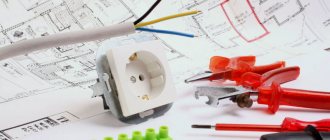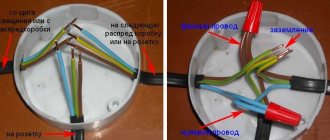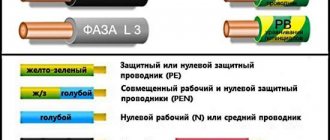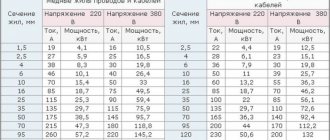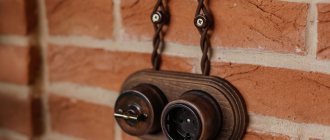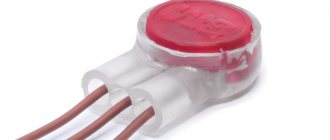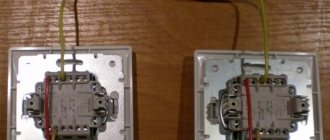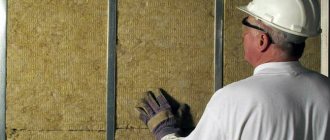Every house, apartment or garage has a connection to electrical networks, where there is often a need to repair old wiring or install new wiring. When laying electrical wiring, it is necessary to connect the cables, and do it reliably, this is the key to the correct operation of electrical devices and safety. This is best done using crimps for electrical cable lugs.
When wires are loosely connected, for example by twisting or soldering, the connection area heats up, which most often leads to a fire. Such an unreliable connection does not provide adequate throughput and causes instability in the electrical network, which leads to failure of electrical equipment.
The connection method using crimping (crimping) wire lugs does not have these disadvantages. To do this, use a special tool - crimpers (crimpers), which ensure tight and high-quality contact.
Where are cable lugs used for crimping?
We can talk endlessly about the areas of application of crimp wire lugs. In order not to overload the reader with unnecessary information, we will consider only the main ones:
- in production. Not a single connection of power lines to each other or to electrical equipment is complete without crimping the cable lugs. This ensures tight contact and, as a result, reliable operation of electrical appliances and equipment. The shape and size of such elements are selected according to the cross-section of the cores and the material of manufacture;
The main advantage of such connections is reliability.
- household sphere. A home craftsman rarely thinks about the benefits of tips, but in vain. If we disassemble any household appliance, we will see that not a single connection is complete without them. In everyday life, elements that differ from industrial ones are used. But they perform the same function: tight contact, no heating and no need for periodic tightening of the terminals.
Additional recommendations
For proper crimping, you must use the following tips:
- Make the junction of the conductors in the center of the connecting tube.
- Select the correct sleeve section. There will be fewer voids inside the clutch, and contact will become more reliable.
- Apply the insulation so that it extends 1 cm beyond the connecting tube on both sides.
- Use ferrules if cables with different numbers of cores are spliced.
Crimping is a procedure that allows you to obtain maximum adhesion of conductors when installing electrical networks. However, to carry it out correctly, the appropriate tools and materials are required.
Marking and decoding
The industry produces a large number of all kinds of tips, which differ in design and materials.
Color coding option
There is a special marking system that allows you to distinguish the material and use it for its intended purpose. Here is a breakdown of some of the symbols:
- A – the sleeve is made of aluminum;
- L – brass is used;
- M – the base of the product is copper;
- T – the element is made of tubular metal;
- U – the connector is made in the shape of an angle.
There is also a designation in the form of the letter O, which indicates the presence of an inspection window through which you can make sure that the cables are correctly located in the sleeve inside.
If the marking is TML (O), then it means tinned tubular copper with an inspection window. NSHVI - means a pin sleeve tip, and NKI - a ring one. In this case, the numbers indicate the cross-sectional area or diameters of the rod. To make it easier to find suitable connectors, for example, NShVI or KVT, you can use a special catalog or tables.
After the letter designations in the markings there are usually numbers that contain information about:
- nominal section;
- diameter of the contact rod;
- internal diameter of the shank.
For example, the product is marked TML (O). This means that this wire termination is made of copper tubing and is tinned. Its distinctive feature is the presence of a small hole - an inspection window, with which you can verify whether the wire is inserted correctly for crimping.
Such contacts are used mainly in production, so not all electricians are aware of their existence.
What does the tip marking mean: full explanation
Each type and type of product has its own alphanumeric marking, without knowing which it is impossible for a home craftsman to explain in the store what he needs. Let's look at popular markings:
- TML is a tin-plated tip, to work with which you need a special tool - a crimper. Looks like NSP. The only difference is that NShP is copper;
- TA – the same tip, but made of aluminum;
- SIP is a self-supporting tip that has its own insulation along the tube and an annular mounting plate;
- NSHVI - common in household use, sleeve pin;
- NKB - used in industry as geophysical cable;
- RFI-M is already a flag tip;
- IEK – copper fork;
- TMD – double blind connectors;
- NKI - isolated ring.
Aluminum products are regulated by GOST-9581-80, copper - GOST-7368-80.
Products for crimping are made of copper, aluminum or bimetal
Types of tips by design
Depending on the design of the terminal and the connected electrical appliance, the shape of the tip is selected. It comes in several types.
| Photo | Name |
| Ring | |
| Fork | |
| Power | |
| Tubular or sleeve | |
| With pin | |
| Socket for quick connection of wires |
The lugs can be used to connect one or two wires; for the second case, special parts are produced. Fixation is carried out by crimping or a bolt built into the shank. The first option is most applicable in everyday life and in production; it is intended for flexible wires made of multiple cores. The second is suitable for rigid cables.
How to choose the right tip for crimping
The correct choice of this electrical installation element depends on the material of manufacture, flexibility, cable cross-section, as well as the method of connection to the device or equipment:
- Cable cross-section is an important aspect. If it is larger, the cable simply will not fit into the sleeve, and if it is smaller, the crimp will not be tight, and there is no point in such a tip.
NShVI are usually sold in such sets, but can also be purchased individually - Flexibility of the wire – this can also lead to a loose connection. For example, we use a product with a bolted connection and a flexible electrical cable. When screwed in, the bolts push the wires apart, pressing only a few “hairs” in the middle. There is no talk of any contact anymore.
- The method of connecting to the equipment may also differ. If switching is not possible with a direct connection, it is necessary to use.
Terminal block connection
A development of the bolted connection is the terminal connection. Terminal blocks come in two types - with a rectangular pressure washer and with a round one. When using a terminal block with a pressure washer, the insulation is removed to a length equal to half the width of the terminal block. The bolt is released, the wire is slipped under the washer and the bolt is clamped again. On one side, you can connect only two wires, preferably of the same cross-section and only flexible or only single-core.
Connecting to a terminal block with a round washer is no different from using a bolted connection.
The connection of the wires is reliable, but cumbersome. When connecting wires with a cross-section of more than 16 mm², the connection is unreliable or the use of lugs is necessary.
Main types of lugs for crimping
Depending on the material from which the tips are made, there are several types of these elements:
- copper – used for cables made of copper conductors;
- tinned copper – tinning treatment provides protection against corrosion;
- aluminum – suitable for aluminum wires;
- aluminum-copper - allow you to connect aluminum and copper wires.
Elements can have different cable connector diameters and bolt mounting holes, different blade sizes and shapes. Some of them are equipped with an inspection window that allows you to adjust the position of the cores inside the part.
Types of tips by material
Copper cable lugs: general information
Copper cable lugs for crimp testing are made from copper pipes of a certain diameter. The pipes are cut and flattened on one side. A hole of a certain diameter for a bolt is made in the flattened part. Produced at special enterprises.
There are two types of copper cable contacts:
- uncoated cable lugs;
- with tinned coating.
Tinned contacts are considered more practical to use. Tinned coating protects the part from corrosion and extends its service life. In addition, tinned contacts are resistant to solutions of nitric, sulfuric and hydrochloric acid.
They are not afraid of exposure to air, moisture and other aggressive environmental factors. Due to the coating, the electrical conductivity of the terminals is reduced. However, it consistently maintains excellent performance.
But uncoated copper contacts will oxidize very quickly. Because of this, the conductivity indicator decreases, the resistance increases, which leads to heating of the connection.
The lugs are used for terminating cables with copper cores. For their installation, special press pliers are usually used, which are used to crimp the end onto the cable.
Copper cable lugs for crimping are used for:
- establishing communication between the power grid and the device;
- establishing contact between devices or a group of devices;
- splicing several electrical wires to increase the length.
Homemade copper
Today there are many cable copper crimp terminations, which, in particular, are very easy to decipher. But there are cases where it is impossible to select a cable lug of the required volume. Then it is possible to use a non-standard option - to create one yourself.
The creation process is simple. To do this, you need to take a copper tube with a certain size. Next, flatten the end and make a hole with the desired diameter.
Homemade copper
NShVI pin lug
NSHVI - insulated pin sleeve end. The sizes of NShVI tips are from 0.25 to 150 mm. Made from tinned electrolytic copper. Designed for household use, suitable for any multi-core wires.
Crimper for pin bushings
The pin lug crimp consists of a series of indentations and tabs, each of a different size. Each hole is used to clamp bushings of a different size.
Each hole has a number that determines what cable section the hole is intended for. For example, this crimp can clamp wires with a cross section from 0.5 mm to 16 mm square.
Sleeves for wires for crimping
Sometimes there is no need to use a ferrule, but crimping the wires with sleeves is required. They can be of two types - GML (tinned copper sleeve) or GAO (copper-plated aluminum sleeve). The choice depends on the cable material.
Good to know! When connecting aluminum wires, it is advisable to use quartz vaseline paste. It prevents the oxidation process from occurring.
Twisted pair cables are crimped in a similar way. The only difference is in the matrices
Connection Features
The technology involves two options for crimping. This is a method of local indentation and continuous compression. Copper or aluminum wires are used for work. The sleeve must also be made of these materials. There are also elements made of copper-aluminum alloy.
Since aluminum cables are prone to the appearance of oxidative films on them, the sleeve must first be cleaned and treated with special lubricants. Copper wires are also pre-treated. The use of lubricants in the process reduces the risk of possible damage to the cores. The friction force is also noticeably reduced. Pressure testing is carried out using manual or hydraulic tools. In the latter case - with a figure press. It is usually used in large industries.
How it works? The two ends of the cable are crimped until they take a round shape. Next, the core is inserted into the sleeve until it stops. It is possible to connect not exactly end-to-end. But in this case, the cross-section of all cores does not exceed the bushing. In the case of local compression, contact directly depends on the depth of the pits. The latter can be measured with a caliper. If continuous compression is used, then check the cross-sectional area. Then, when the crimping of the wires is completed successfully, it is necessary to treat the outer layer with electrical tape or elbow cloth. Next, the wire and cable are carefully laid in the junction box.
Why crimping?
Soldering a stranded wire is not the easiest operation, because you need to expose all the wires, make sure that they are clean in terms of contact, and only then start soldering. Any core in a stranded wire has insulation, and this often creates difficulties in establishing reliable contact.
Just crimping the cable lugs solves all these problems, because with the help of mechanical force (compression) not only the insulation of individual cores is destroyed, but also a strong connection of the entire cable is created for better contact.
This is where the moment arises of how to choose the correct sleeves for crimping wires, because they are made from different materials and have very precisely specified current characteristics.
The problem is that the size of these cartridges is small, and the markings are unclear to those who are not specialists. But before that, let's define the difference between a sleeve and a cable crimp lug.
Another point that is not even in the markings is the moment of tightening the sleeve or tip during crimping. And they are completely different for different types of tips, such as:
- ring (NKI).
- fork (NVI).
- pin round (NSHKI).
- flat (plug) connectors (RPI-P, RPI-M, RSHI-P, RSHI-M, etc.).
- piercing type couplers (OV).
Here it is necessary to return to the tool that is used to crimp the wires, because on each tool the dimensions are indicated for the standard shape of the jaws, and the force itself is accurately measured by diameters. So, unless you made a mistake with the diameter, you cannot apply excessive force.
And, despite the fact that the lugs for wires for crimping are different, with the same diameter both the force and the standard of the tool will be the same. It's a pity that this parameter is not reflected on the labeling. Apparently because such work is usually done by professionals, not home electricians.
But it is precisely the standards that allow home electricians to stock up on universal crimping pliers and crimp cable lugs for their own purposes without any problems. This procedure is quite simple to master, and technologically it is the same for crimping an RG-45 connector and a tip for a three-phase machine.
When crimping a multi-core cable, you cannot do without special lubricants. Therefore, use sleeves and tips that already have this lubricant inside. In any case, this is a one-time operation. It is not possible to remove a part to move it to another location.
As a result, having mastered the installation of sleeves and tips, you will be able to quickly restore the desired connection, carry out repairs without problems, as well as a connection that, in fact, will not need repair for many years.
Technical specifications
The main types and brands of thin-walled insulated lugs and terminals widely represented on our market are the following:
NKI ring tips - all their data and technical parameters are given at the beginning of the article above.
NVI insulated fork lugs:
Insulated flat pin lugs NSHPI:
Insulated round pin lugs NShKI:
Connectors—flat insulated “female” terminals RPI-M:
Connectors - flat insulated male terminals RPI-I:
You can view the current prices for tools for crimping such tips here.
Preparation for crimping
To crimp using a cable lug, you need to prepare the wire. See the table below for how to do this.
| Photo | Action |
| Measure the depth of the shank, add 5 mm and make a mark on the cable | |
| Clean the conductors from the insulating layer, check that the edge is smooth | |
| Degrease the wire and put a tip on it, the wires should fit tightly inside the shank |
Procedure for crimping cable lugs and sleeves
For crimping thick-walled tips and sleeves, it is best to use a hydraulic press. The press set initially includes universal dies for any tips and wires.
Under no circumstances use a tool not intended for crimping (hammer, chisel, etc.). A contact pressed in this way will not last long, especially if it constantly experiences heavy loads.
The next question that arises for an ignorant user is: how many times should I press the tip with a press? Once, twice or three times?
This depends on 2 parameters - the length of the tip and the width of the matrix.
In the operating instructions for the press that comes with the tool, there is a sign indicating the required number of crimps. Please note that this table is intended for tips and sleeves made in accordance with GOST.
Insert the tip into the press so that the matrix cross-section markings (35-50-70, etc.) are imprinted on the front side of the tip, and not on the side or bottom.
- do the first crimp test closer to the blade (where the bolt is inserted);
- Perform the following crimps in order, moving from the blade to the tail of the tip.
The same rules apply for connecting sleeves.
This must be done in this sequence, because with each press the tip tends to lengthen (sometimes up to ten percent!).
And if you start pressing from the end (not from the blade), during the last crimp, there is a high probability that you will have a void at the end of the sleeve. And you will not achieve the contact that was necessary. First of all, this applies to all aluminum products. For copper this is not yet so critical.
Preparatory work with the cable
Strip the insulation from the cable cores to the required length. What is this length?
It should be equal to the depth of the tip, plus 5mm margin.
A reserve is required because the tip will be stretched and deformed during crimping (especially aluminum). Try to make the cut of the insulation even, strictly at an angle of 90 degrees to the axis of the cable itself.
If the cable cores are triangular in shape, they must be ground off with a rounding file. Otherwise, you will never achieve this density during crimping:
After removing the insulation, the bare core must be cleaned and degreased. To do this, use special contact pastes.
Ferrule crimping
To find out which tool is best to use for crimping various types of tips, watch this video:
As you can see, you don’t need any special intelligence or experience to use the tips; everything is done easily and quickly. The only thing you will need are special devices - a stripper and press pliers, but they are affordable and can be purchased. When connecting multi-core conductors, be sure to use lugs and make the power supply as reliable and safe as possible.
How to crimp a wire: instructions for single and double NShVI
The wire with the tip must be installed in press jaws in a matrix of a suitable size. During the crimping process, you need to ensure that the wire does not move inside the sleeve. The first crimp is done with an indentation of 1–2 mm from the edge, if necessary, the second at the same distance from the first.
The handle of the press pliers is compressed until it is in full contact with the surface of the part and the matrix is connected, then the sleeve is moved and a second crimping is done. If the shank is long, work continues until the colored skirt.
The crimping scheme for a double tip is practically the same. You only need to insert two wires into one hole in the shank at the same time.
Stages of wire crimping
Visual instructions for crimping a wire with an NShVI lug are presented in the video:
Crimping power cable lugs
When crimping power cables, tinned copper lugs are used, which are well protected from corrosion. If, when cutting the cable, its cores “fluff” significantly and become larger in diameter than the rest, then perform the work on a sharpener. When unrolling the cable, make sure that the circle removes excess knots along the cores and does not bend them.
Soldering is absolutely not suitable for crimping a power cable, since single tin contacts cannot be used on such wires.
Junction box
Wires from the electrical panel are distributed to individual rooms of the apartment or house. Moreover, each room usually has not one, but several connection points (sockets and switches). To standardize the connection of conductors and concentrate them in one place, distribution boxes are used (their other names are “junction boxes” or “branch boxes”). The boxes contain cables from all consuming devices.
The wires in the box are not laid chaotically, but in accordance with clear rules prescribed in the Electrical Installation Rules (PUE). According to the requirements of the PUE, all connections of wires in the box, as well as branches, are made only inside the junction box. The conductors are directed along the top of the wall, but no closer than 15 centimeters from the ceiling. When the cable reaches the branch section, it descends strictly vertically. At the branch site there is a distribution box. The connections in it are made according to the existing diagram.
Junction boxes are classified by installation type. There are internal and external junction boxes. There is a niche in the wall for hidden-mounted boxes. Only the cover remains on the surface, which is installed flush with the finishing material. It is allowed to cover the lid with decorative panels. If the thickness of the walls or other circumstances do not allow the installation of an internal junction box, it is mounted directly on the wall.
The distribution box can be rectangular or round. The number of pins is usually four, but in some cases there are additional pins. Each outlet is equipped with a fitting or thread for securing a corrugated hose. The presence of such a hose or plastic pipe greatly simplifies the process of laying and replacing wires. To replace the wires, it will be enough to disconnect the hose or pipe from the junction box and the consumer, and then pull it out. After replacing the conductors, the hose is returned to its place. If the wires are located in a groove, you will need to break up the layer of plaster, which is much more labor-intensive.
The use of junction boxes leads to the following positive results:
- The maintainability of the electricity supply system increases. Since all connections are easily accessible, it is much easier to find the damaged area.
- The overwhelming majority of faults are found at joints. Since all connections are concentrated in one place, it is easier to carry out preventive inspections.
- Thanks to junction boxes, the degree of fire safety increases.
- The use of junction boxes allows you to save money and reduce labor costs when laying cables.
Why can't you twist the wires?
The wires inside the bushing are crimped under very high pressure, so that they can even change their original circular shape if they lie parallel to each other. From a circle they turn into a hexagon, and this increases the area of their contact surface with each other.
And when you twist them, during crimping, in those places where the veins intersect, they can be pressed against each other.
Required Tools
Crimping is carried out with a special tool that allows you to create the necessary force. The following tools are popular:
- Press pliers for crimping PK2 and PK2M lugs are used for terminating cores with a cross-section of up to 10 sq. mm;
- PK1 and PK1M brand tools are a more powerful version of hand pliers;
- hydraulic pliers allow you to crimp wires up to 10 sq. mm;
- In industrial production, a hand press is used. It is suitable for wires up to 240 sq. mm;
- hydraulic press with electric drive is used for cables up to 300 sq. mm.
Types of instruments
Press pliers with hinges increase the pressure of the tool, which makes the manual crimping process easier. Devices with a ratcheting mechanism are especially convenient. They prevent the instrument from unclenching until the procedure is completed.
You can watch how to crimp a wire without tools in this video:
Types of press jaws
The manual crimper is used for crimping non-insulated cable lugs, contact connectors, terminals and contact sleeves of various sizes. If a manual crimper has special blades (usually they are located where the handles are attached), then this tool can also be used for cutting cables and wires.
Electric pliers are a multifunctional tool for professional use. They can do almost any work with wires. Electric pliers are mainly used for cutting and stripping wires, but they can also be used to crimp uninsulated and insulated cable ends.
A crimper is a tool for crimping wire lugs, twisted pair cables, and connectors. It has two long handles (one or both can be movable) and a massive working part in the form of metal jaws, which have holes for cables.
When the handles are brought together, the jaws close and the cable connector is crimped using forceful pressing. Some models have a blade on the working part, which simplifies the work - no additional tools are required to cut the cable.
How to choose press jaws
The choice of crimping tool is determined by the cross-section of the wire. The larger it is, the more powerful the device should be. Human effort is not enough to create a tight and uniform pressure, even when using household tips.
Crimping of cable lugs is performed using one of the following tools:
- Press pliers of brands PK2 or PK2M - for manual use, suitable for wires with a cross-section of up to 10 sq. mm.
- Hydraulic pliers – designed for terminating cables up to 10 sq. mm.
- Press pliers for crimping terminals, brands PK1 or PK1M - similar to the first tool, but reinforced with long handles, due to this they are capable of crimping a wire up to 50 sq. mm.
More powerful devices, such as manual and hydraulic presses, are used in production. With their help, you can crimp wires with a cross-section of up to 30 sq. mm.
Hand press pliers for home use
How to crimp wire lugs without tools
What to do if you don’t have special tools for crimping on hand or you just don’t want to buy them if you only need to crimp one or two tips?
Many, faced with this problem, resort to incorrect methods, which in the future only worsen the contact, without ensuring a reliable connection. They begin to flatten the tip with hammers, simply squeeze it in a bench vice, crush it with pliers, and press it in with a chisel. All these methods are incorrect and do not bring the desired result. After such amateur activity, poor contact is obtained with its further heating during operation.
Where to buy cable lugs for crimping
Before you go to the store, you should familiarize yourself with the options offered on the market in advance. The table shows prices for some cable lugs for crimping.
Photo Products Characteristics Average price, rub.
| Tinned copper tip GPH (w = 29 mm) 120 mm.sq.*M 16 | The flange shape is ring. Material copper. | 320 | |
| Tinned copper tip GPH (w = 29 mm) | |||
| Sealed insulated tips NIM 25 (CPTAU 25) IEK | Combined material - copper and aluminum. Cross section 25 sq. mm. Longitudinal sealing available | 268 | |
| Sealed insulated tips NIM 25 (CPTAU 25) IEK | |||
| Tinned copper tip TML 2.5mm.sq. x M5 (W=10mm) | Material copper. Cross section 2.5 sq. mm. Ring flange shape. | 433 | |
| Tinned copper tip TML 2.5mm.sq. x M5 (W=10mm) | |||
| Navigator NShvi 10-12 NET-E10-12 isolated 4670004710920 155767 | Material tinned copper. Polyamide insulation. | 536 | |
| Navigator NShvi 10-12 NET-E10-12 isolated 4670004710920 155767 | |||
| Pin sleeve insulated tip NSHVI2 2.5-10, 50 pcs Peredovik 26685 | PVC insulation. Material tinned brass. Wire cross-section 2.5 sq. mm. | 87 | |
| Pin sleeve insulated tip NSHVI2 2.5-10, 50 pcs Peredovik 26685 | |||
Pin sleeve insulated tip NSHVI2 2.5-10, 50 pcs Peredovik 26685
To choose a quality product, remember that each tip must have a specific wire. The discrepancy between these two elements most often leads to errors when performing crimping. You cannot use homemade tips or cut the sleeve into two parts to save money. We hope that our advice will be useful to you and help you make the right choice.
Twist connection
The easiest way to connect wires is twisting. Previously, this was the most common method, especially when wiring in a residential building. Now, according to the PUE, connecting wires in this way is prohibited. The twist must be soldered, welded or crimped. However, these methods of connecting wires begin with twisting.
In order to perform high-quality twisting, the connected wires must be cleared of insulation to the required length. It ranges from 5 mm when connecting wires for headphones to 50 mm if it is necessary to connect wires with a cross-section of 2.5 mm². Thicker wires are usually not twisted together due to their high rigidity.
The wires are stripped with a sharp knife, insulation stripping pliers (ISR) or, after heating with a soldering iron or lighter, the insulation is easily removed with pliers or side cutters. For better contact, bare areas are cleaned with sandpaper. If the twist is supposed to be soldered, then it is better to tin the wires. Wires are tinned only with rosin and similar fluxes. This cannot be done with acid - it corrodes the wire and it begins to break at the soldering site. Even washing the soldering area in a soda solution doesn’t help. Acid vapors penetrate under the insulation and destroy the metal.
The stripped ends are folded parallel into one bundle. The ends are aligned together, the isolated part is held firmly with your hand, and the entire bundle is twisted with pliers. After this, the twist is soldered or welded.
If there is a need to connect the wires to increase the total length, then they are folded opposite each other. The cleaned areas are placed crosswise on top of each other, twisted together by hand and tightened tightly with two pliers.
You can only twist wire made of the same metal (copper with copper, and aluminum with aluminum) and of the same cross-section. Twisting wires of different sections will turn out uneven and will not provide good contact and mechanical strength. Even if it is soldered or crimped, these types of wire connections will not ensure good contact.
